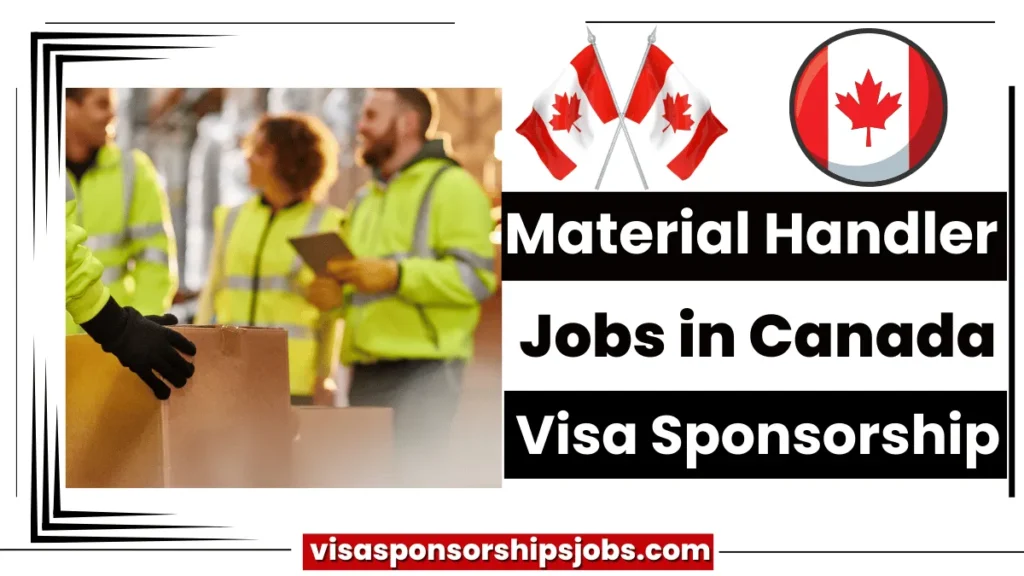
Material management is a vital component of many industries, from production to logistics. In Canada, the demand for professional fabric handlers continues to develop as agencies strive for the efficiency and safety of their operations.
For 2024, there are various opportunities for overseas employees to stable fabric handler jobs in Canada with visa sponsorship. This blog will explore the process requirements, advantages, duties, income expectations, different styles of material handler jobs, and the software manner.
Job Details
- Location: Various locations across Canada
- Job Type: Full-time
- Country: Canada
Job Requirements
To qualify for a material handler task in Canada, applicants typically want to fulfill the following necessities:
- Education: A high college diploma or equal is commonly required. Some positions might also require additional vocational schooling or certification.
- Experience: Prior experience in material handling or a related discipline is regularly favored however no longer always obligatory. On-the-task education is common.
- Safety Awareness: Knowledge of the place of business safety practices and pointers is crucial.
- Communication Skills: Basic conversation talents, both verbal and written, are important for know-how commands and coordinating with group people.
- Work Authorization: Eligibility to paintings in Canada through visa sponsorship or a different criminal approach.
Benefits
Working as a cloth handler in Canada gives several blessings:
- Competitive Salary: Material handlers can earn an excellent wage, with possibilities for extra-time pay.
- Job Security: The demand for fabric handlers is steady, offering lengthy-term job security.
- Work-Life Balance: Depending on the agency, job schedules can offer flexibility, which includes options for shift work.
- Training Opportunities: Employers regularly provide on-the-job education and certification applications to beautify capabilities.
- Diverse Work Environment: Working with human beings from diverse backgrounds in a multicultural setting.
- Employee Discounts: Some groups provide reductions on services and products.
- Retirement Plans: Employers may also provide retirement financial savings plans and pension schemes.
- Relocation Assistance: For worldwide employees, a few companies offer relocation assistance and assistance for settling in Canada.
Duties
The obligations of a material handler can vary depending at the industry and precise process function but normally encompass:
- Receiving and Unloading: Unloading substances from delivery trucks and verifying quantities towards delivery files.
- Storage Management: Organizing and storing materials in targeted regions the usage of devices which includes forklifts.
- Inventory Control: Keeping tune of inventory degrees and reporting discrepancies.
- Safety Compliance: Adhering to protection protocols and retaining some clean work surroundings.
- Documentation: Completing necessary paperwork and retaining accurate facts.
- Team Collaboration: Working with different group contributors to ensure smooth operations.
Salary
The income for cloth handlers in Canada can vary based on area, revel, and industry. On average:
- Entry-Level: $15 – $20 per hour
- Experienced: $20 – $25 in keeping with hour
- Supervisory Roles: $25 – $35 in step with hour
Types of Material Handler Jobs
Construction Material Handler: Manages substances on production websites, ensuring well-timed transport and the right garage.
Freight Material Handler: Works in transportation and logistics, coping with freight in transport yards and distribution facilities.
Forklift Operator: Specializes in working forklifts to transport heavy materials.
Stock Clerk: Focuses on preserving stock ranges and organizing stockrooms.
Receiving Clerk: Manages the receipt of incoming substances and verifies their accuracy.
Shipping Clerk: Prepares and applications materials for outgoing shipments.
Production Material Handler: Supports production lines through the use of ensuring a constant supply of substances.
Job Application Process
Securing a fabric handler process in Canada with visa sponsorship involves numerous steps:
- Research: Identify businesses and industries that lease material handlers and offer visa sponsorship.
- Prepare Resume: Create a resume highlighting applicable talents, experience, and qualifications.
- Apply Online: Submit programs through business enterprise websites or job portals consisting of Indeed, Workopolis, and Job Bank.
- Network: Connect with enterprise experts and attend task fairs to increase your probability of locating opportunities.
- Job Offer: If decided on, you may get hold of a task provided, which can be conditional upon acquiring a piece visa.
- Visa Application: Apply for a piece visa through the Canadian authorities’ immigration internet site. Your agency will want to provide a Labour Market Impact Assessment (LMIA) to guide your software.
- Medical Exam: Complete a scientific exam as required by Canadian immigration authorities.
- Submit Documents: Provide all vital documentation, which includes your job provide, LMIA, medical exam outcomes, and other assisting files.
- Visa Approval: Once your visa is accredited, make tour arrangements and prepare for your move to Canada.




